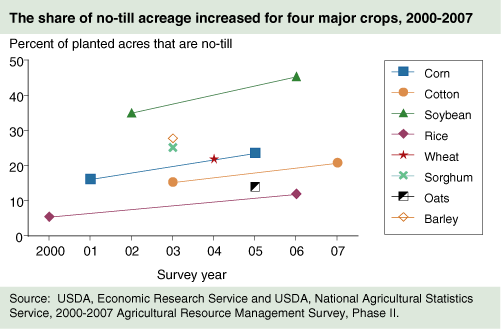U.S. Farmers Increasingly Adopt “No-Till” for Major Crops
- by John Horowitz, Robert Ebel and Kohei Ueda
- 12/1/2010
Widespread adoption of less intensive tillage practices could enable U.S. agriculture to sequester substantial amounts of carbon and contribute to efforts to reduce greenhouse gas emissions. Less intensive tillage would also reduce water sedimentation and chemical pollution as well as atmospheric dust and haze.
Tillage—turning the soil to control for weeds and pests and to prepare for seeding—has long been part of crop farming. However, intensive soil tillage can increase the likelihood of soil erosion, nutrient runoff into nearby waterways, and the release of greenhouse gases into the atmosphere. A reduction in how often or how intensively cropland is tilled enables the soil to retain more organic matter, which helps store, or “sequester,” carbon and leaves the soil less susceptible to wind and water erosion.
ERS researchers compiled data on U.S. tillage practices using USDA’s Agricultural Resource Management Survey (ARMS) and the National Resources Inventory (NRI). ARMS, which provides some of the most reliable nationwide information on farming production practices, suggests that no-till operations accounted for an estimated 35 percent of the cropland planted to eight major crops in the U.S. in 2009. The crops—barley, corn, cotton, oats, rice, sorghum, soybeans, and wheat—constituted 94 percent of total U.S. planted acreage in 2009. Furthermore, the use of no-till increased over time for corn, cotton, soybeans, and rice, the crops for which the ARMS data were sufficient to calculate a trend.
No-till adoption varied substantially across crops, however, even for those that have generally similar production practices. For example, land planted to barley had roughly twice the percentage of no-till (27 percent in 2003) as land planted to oats (14 percent in 2005).
Greenhouse gas benefits are largest when no-till is practiced over a prolonged period. NRI’s Conservation Effects Assessment Project Cropland Survey collected data on farming practices during 2003-06. In the Upper Mississippi River Basin, one of the Nation’s major growing areas, 13 percent of cropped acres were in no-till for 3 consecutive years during the relevant survey period.
Together, ARMS and NRI data indicate that efforts to increase the adoption of less intensive tillage practices by U.S. farmers could be an important component of policies designed to reduce greenhouse gas emissions and help protect the environment.
This article is drawn from:
- Horowitz, J., Ebel, R. & Ueda, K. (2010). "No-Till" Farming Is a Growing Practice. U.S. Department of Agriculture, Economic Research Service. EIB-70.


